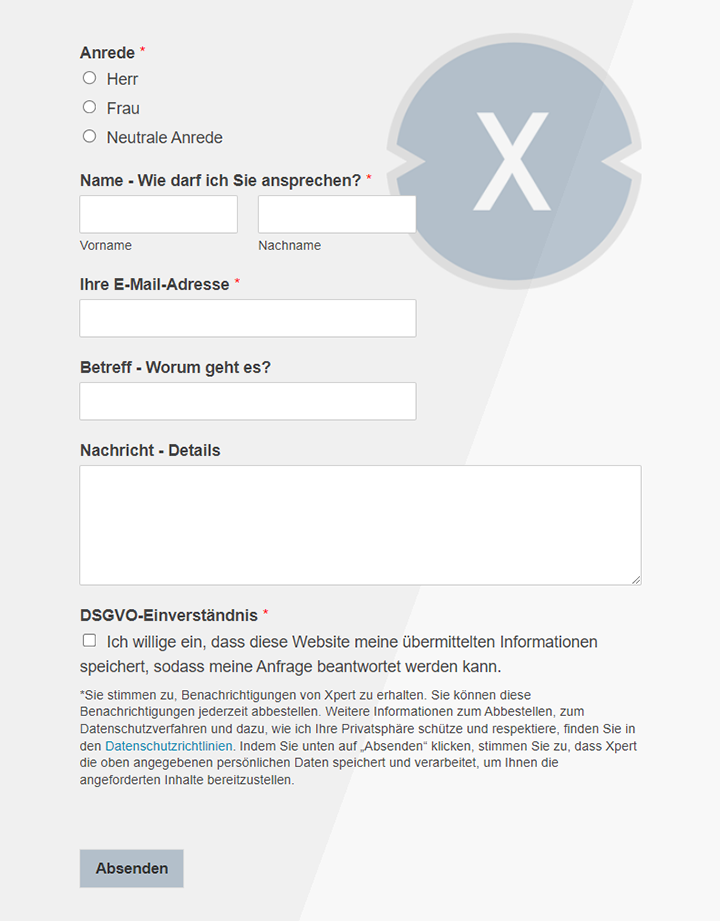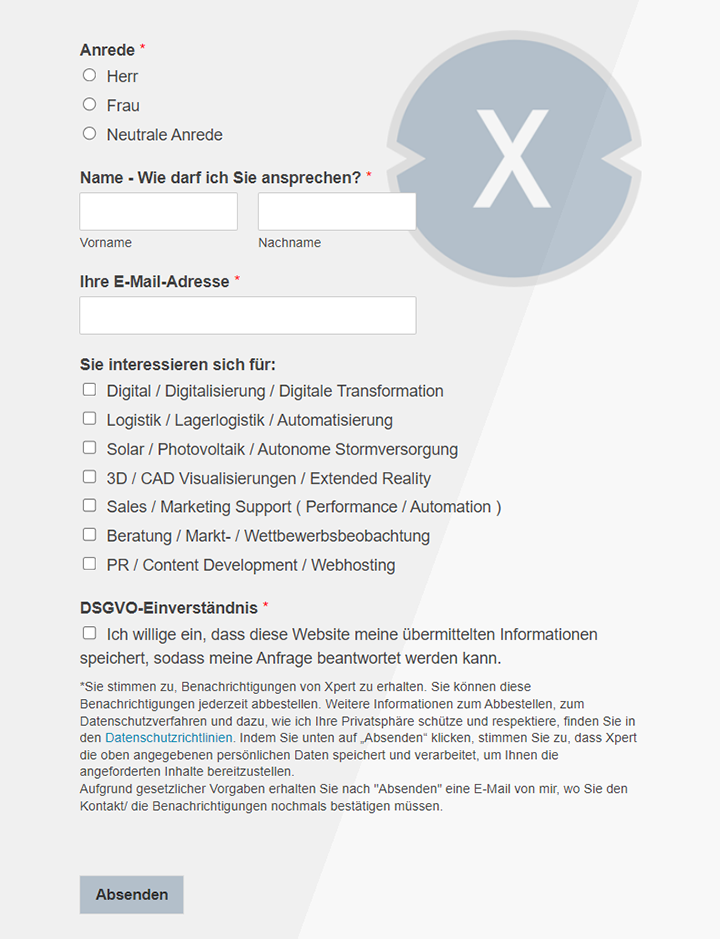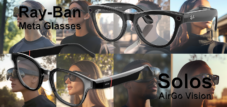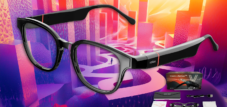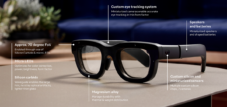Not augmented reality yet, but smart: The comparison between Ray-Ban Meta Glasses and Solo's AirGo V (Vision) smart glasses
Xpert pre-release
Language selection 📢
Published on: December 24, 2024 / Update from: December 29, 2024 - Author: Konrad Wolfenstein
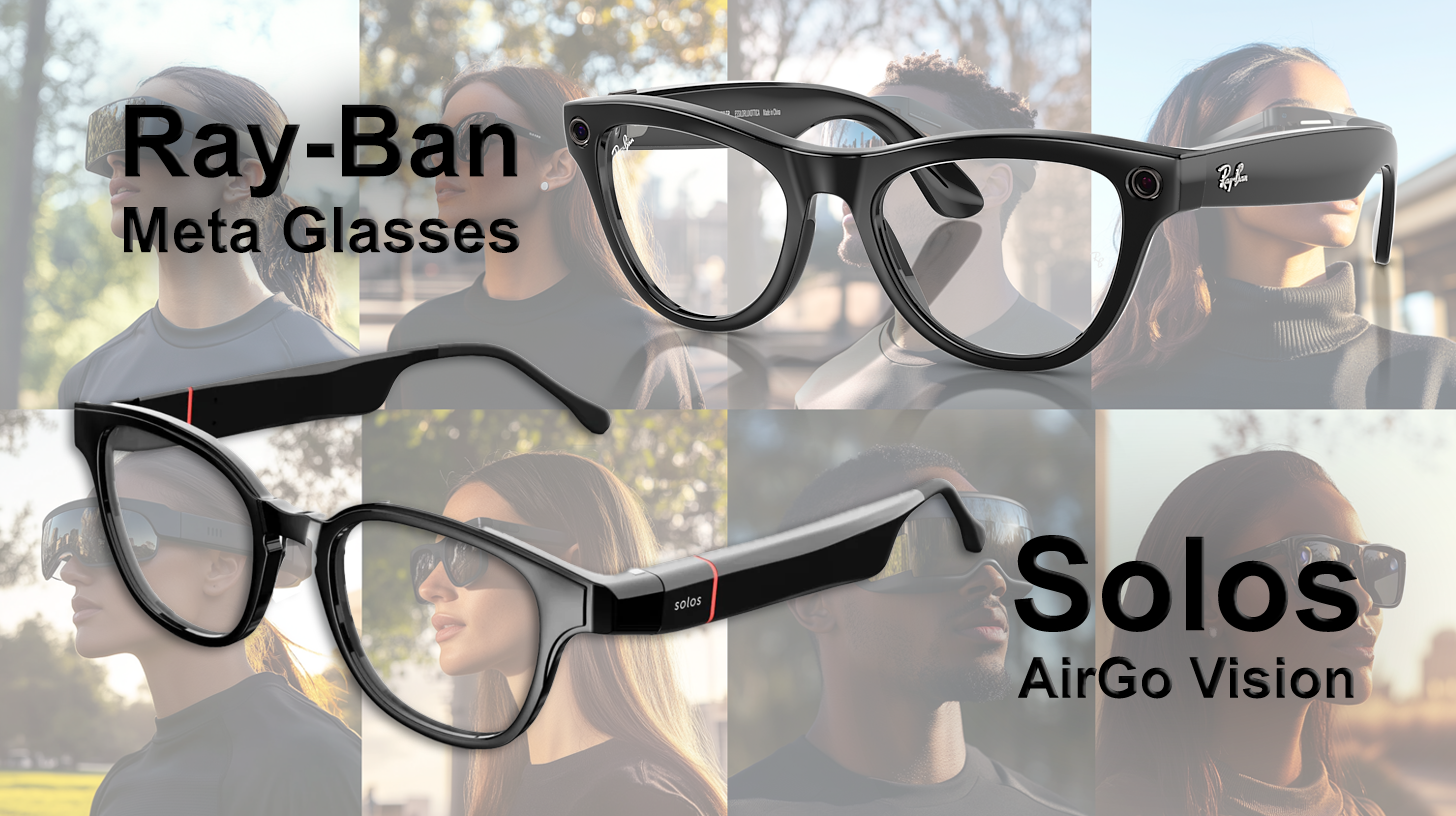
Precursor to real intelligent glasses – still without augmented reality XR functionality – Image: Xpert.Digital
Comparison: Solo's AirGo V (Vision) Smartglasses and Ray-Ban Meta Glasses - precursor to real intelligent glasses - still without Augmented Reality XR functionality
The Solos AirGo V (Vision) smart glasses and the Ray-Ban Meta glasses are two exciting representatives of the new generation of smart glasses. They combine modern technology with everyday utility, but they differ in several key aspects such as AI integration, hardware design, features and future viability.
AI integration and assistants
A key difference between the two models lies in the integration of artificial intelligence (AI). The Solos AirGo V rely on an open architecture, while the Ray-Ban Meta Glasses are heavily tailored to the meta ecosystem.
Solo's AirGo V
The AirGo V offers impressive flexibility when choosing the AI assistant. Users can choose between different AI frameworks such as OpenAI GPT-4.0, Anthropic's Claude or Google Gemini. This enables individual adaptation to specific needs. The integration of ChatGPT-4.0 allows complex interactions that go far beyond simple voice commands.
Ray-Ban Meta Glasses
The Ray-Ban Meta Glasses, on the other hand, are closely linked to Meta AI, which is based on the LLaMA-2 framework. These glasses offer solid AI integration, but the functionality is limited to the meta ecosystem. For example, AI can recognize landmarks and provide information about them, but the choices for other AI frameworks are lacking.
Hardware and design
Both models emphasize a slim, everyday design, but with different approaches aimed at specific target groups.
Solo's AirGo V
The AirGo V is characterized by a removable camera module that emphasizes user privacy. Weighing just 42 grams, they are lighter than most of their competing models. The interchangeable frame system also allows for customization to suit different styles and functions, making the glasses more versatile.
Additional hardware highlights:
- Battery life for up to 2,500 AI interactions or photo captures
- 10 hours of music streaming or 7 hours of calling per charge
Ray-Ban Meta Glasses
The Ray-Ban Meta Glasses rely on a permanently integrated camera module and a classic design that is strongly reminiscent of the iconic Wayfarer glasses. Weighing 50 grams, they are only slightly heavier than standard glasses models. The design is aimed at a target group that values style and functionality equally.
Hardware details:
- Battery life of around 4 hours, expandable with a charging case with up to 8 additional charges
- Weight only 5 grams more than conventional Wayfarer glasses
Features in comparison
Both models offer innovative functions, but the focuses are different.
Solo's AirGo V
- Real-time translation function: The SolosTranslate technology translates conversations in real time, making the glasses particularly attractive for frequent travelers.
- Fitness tracking: With integrated sensors, the AirGo V offers comprehensive fitness tracking options that are interesting for physically active users.
- Privacy focus: The removable camera module underlines the idea of data protection.
Ray-Ban Meta Glasses
- Live streaming: One of the standout features is the ability to stream directly to Facebook or Instagram. This particularly appeals to content creators.
- Music control: Spotify and Amazon Music can be controlled with voice commands, which offers a high level of ease of use.
- Reminder function: With a simple voice command, photos can be taken and saved as visual reminders.
Price and availability
- Solos AirGo V: The price of the glasses starts at 290 euros or 299 dollars, with market entry from December 23, 2024.
- Ray-Ban Meta Glasses: These start at just $299.
How close are both models to Augmented Reality (AR) and Mixed Reality (MR)?
While both glasses are innovative wearables, they still lack a lot to be considered true AR or MR glasses. They offer smart functions that can be viewed as a precursor to real augmented reality.
Current features
Solos AirGo V and Ray-Ban Meta: Both models have cameras, voice assistants and audio functions such as music playback and calls. But neither visual AR overlays nor displays for virtual objects are integrated.
Differences from real AR/MR glasses
- Missing AR core functions: Real AR glasses like the XReal Air 2 Ultra or Meta Orion have built-in displays that can overlay virtual content on top of the real world.
- Limited technical features: Sensors for depth detection, 3D mapping or advanced tracking are missing from both models.
- No spatial tracking: Interactions with virtual objects in real space are currently not possible.
Conclusion on AR/MR capability
The Solos AirGo V and the Ray-Ban Meta Glasses are innovative wearables, but they clearly differ from real AR or MR glasses. They represent an intermediate stage on the path to more comprehensive AR technologies expected in the coming years.
Who are the respective models suitable for?
Solo's AirGo V
The AirGo V is aimed at users who value flexibility and data protection. Frequent travelers, technology enthusiasts and fitness fans particularly benefit from the translation and tracking functions. The open AI integration also makes it ideal for users who value individual customization.
Ray-Ban Meta Glasses
The Ray-Ban Meta Glasses appeal to a target group that is style-conscious and values easy integration into social media. Content creators and music lovers benefit from the live streaming and music control functions.
🎯🎯🎯 Benefit from Xpert.Digital's extensive, fivefold expertise in a comprehensive service package | R&D, XR, PR & SEM

AI & XR 3D Rendering Machine: Fivefold expertise from Xpert.Digital in a comprehensive service package, R&D XR, PR & SEM - Image: Xpert.Digital
Xpert.Digital has in-depth knowledge of various industries. This allows us to develop tailor-made strategies that are tailored precisely to the requirements and challenges of your specific market segment. By continually analyzing market trends and following industry developments, we can act with foresight and offer innovative solutions. Through the combination of experience and knowledge, we generate added value and give our customers a decisive competitive advantage.
More about it here:
Future on the head - comparison of visions: AirGo V or Ray-Ban Meta - which smart glasses are the right ones?
The world of smart glasses is evolving rapidly, and two models that are currently attracting a lot of attention are the AirGo V (Vision) smart glasses from Solos and the Ray-Ban Meta Glasses. Although both glasses aim to seamlessly integrate technology into our everyday lives, there are key differences that make them interesting for different user groups.
Key differences in AI integration
A key difference lies in the way artificial intelligence is integrated into the glasses. The AirGo V smartglasses rely on the power of ChatGPT-4.0 and also offer an open architecture that enables the use of various AI frameworks such as OpenAI GPT-4o, Anthropic's Claude and Google Gemini. This means users have the flexibility to use the AI assistant of their choice and potentially benefit from the strengths of different models. In contrast, the Ray-Ban Meta Glasses use Meta AI, which is based on the in-house LLaMA 2. This limits the choice of AI assistant, but at the same time provides seamless integration into the meta-ecosystem. You could say that the AirGo V takes a more open, customizable approach, while Meta relies on a more controlled, in-house solution. The decision for one system or the other depends largely on the user's preferences - does he value freedom of choice or smooth integration into an existing environment?
Design and Hardware: A Comparison of Approaches
There are also striking differences in the field of design and hardware. Airgo V is characterized by a removable camera module, which offers a clear advantage in terms of privacy. Users can remove the camera if necessary and thus disperse concerns regarding unwanted recordings. With a weight of 42 grams, the Airgo V is also a little lighter than the Ray-Ban Meta, which weighs 50 grams. This difference may seem low, but can be noticeable when carrying for a long time. The Ray-Ban Meta, on the other hand, integrates the technology more inconspicuously into the design of a classic Ray Ban glasses, which at first glance is less perceived as a “tech gadget”. The fixed camera module may be a disadvantage for some, but guarantees a always ready to use. The battery life also varies: Airgo V promises up to 2,500 AI interactions or photo recordings with a load, while the Ray-Ban Meta offers a battery life of around 3 hours. This shows that the Airgo V is potentially interesting for users who want to use their smartglasses intensively for AI-based applications, while the Ray-Ban Meta is more designed for shorter, spontaneous missions.
Functions in detail: What can the glasses do?
In the functions, both glasses offer similar basic options such as photo and video recordings, audio output and voice control. However, the Airgo V stands out with its real-time translation function “Solostranslate”, which can be of great benefit, especially for travelers or in international contexts. In addition, it offers fitness tracking functions, which makes it a potential companion for sporting activities. The Ray-Ban Meta, on the other hand, scores with a direct live streaming function for Facebook and Instagram, which makes it attractive for social media-savvy users. The integrated memory function with photo recordings can also be practical in everyday life to capture moments and access later. The integration of Spotify and Amazon Music with voice control is another feature that makes the Ray-Ban Meta interesting for music lovers. It can be said that Airgo V places a stronger focus on productivity and versatile applicability, while the Ray-Ban Meta is geared towards social interaction and entertainment.
Price and availability: When and at what price are the glasses available?
There are also differences in price and availability. The AirGo V is available at a price of 290 euros or 299 dollars and is scheduled to be delivered from December 23, 2024. The Ray-Ban Meta is available starting at $299. This means that the Ray-Ban Meta is currently more accessible. The similar price suggests that both companies position their products in the same market segment.
Special functions of the Ray-Ban Meta compared to the AirGo V
The Ray-Ban Meta Glasses offer some special features that set them apart from the AirGo V. The ability to recognize and provide information about landmarks is an interesting feature for tourists and explorers. Greater integration into the meta ecosystem enables features such as the aforementioned live streaming and easy participation on social media. The collaboration with the established eyewear brand Ray-Ban also gives the Meta Glasses a fashionable aspect and a certain everyday suitability that is sometimes missing from pure technology products. The AirGo V, on the other hand, as already mentioned, relies on a more open platform and offers more options for customizing the style and functions with the interchangeable frame system. The focus on data protection through the removable camera module is another unique selling point.
The path to augmented and mixed reality: How far away are the smart glasses?
It is important to emphasize that both the Solos Airgo V and the Ray-Ban Meta Glasses still have a clear distance from real augmented reality (AR) or mixed reality (MR). Both models currently offer integrated cameras, voice assistants and audio functions, but they lack core functions that characterize AR/MR glasses. Above all, this includes a built -in display that enables visual overlays in the real world. Real AR/MR glasses are able to show digital information into the user's field of vision and enable interactions with virtual objects in real space. This requires advanced sensors for spatial recording, more powerful processors and often also hand and eye tracking for intuitive operation. Current smartlasses such as the Airgo V and the Ray-Ban Meta can be considered more than a preliminary stage or a first step towards AR/MR. They expand reality in an auditory and informative way, but the visual dimension of augmented reality is still reserved for future developments. These are innovative wearables that offer useful “smart” functions, but still do not enable Immersive AR experience. The path to full-fledged AR/MR glasses still requires considerable progress in the areas of display technology, battery power and miniaturizing the necessary hardware.
Two different approaches to smart glasses
In summary, both the AirGo V and the Ray-Ban Meta are exciting products in the field of smart glasses, but they have different focuses. The AirGo V impresses with its open AI platform, the flexibility in choosing the assistant and the ability to remove the camera for more privacy. The real-time translation function and fitness tracking functions expand its scope. The Ray-Ban Meta, on the other hand, scores with its seamless integration into the Meta ecosystem, the social media functions and the fashionable design of the Ray-Ban brand. The ability to recognize landmarks and integrate music services are additional pluses. The decision for one of the two glasses depends largely on the individual needs and preferences of the user. Anyone who values maximum flexibility in AI use and data protection could gravitate toward the AirGo V. However, those who are strongly rooted in the meta ecosystem and prioritize social media functions will find the Ray-Ban Meta an interesting option. Both glasses impressively demonstrate the potential of smart glasses to enrich our everyday lives, even if the path to real augmented or mixed reality glasses still requires a lot of development. The current models should be seen as intelligent assistants on the ear and nose that provide information, capture moments and simplify interaction with our digital world.
We are there for you - advice - planning - implementation - project management
☑️ SME support in strategy, consulting, planning and implementation
☑️ Creation or realignment of the digital strategy and digitalization
☑️ Expansion and optimization of international sales processes
☑️ Global & Digital B2B trading platforms
☑️ Pioneer Business Development
I would be happy to serve as your personal advisor.
You can contact me by filling out the contact form below or simply call me on +49 89 89 674 804 (Munich) .
I'm looking forward to our joint project.
Xpert.Digital - Konrad Wolfenstein
Xpert.Digital is a hub for industry with a focus on digitalization, mechanical engineering, logistics/intralogistics and photovoltaics.
With our 360° business development solution, we support well-known companies from new business to after sales.
Market intelligence, smarketing, marketing automation, content development, PR, mail campaigns, personalized social media and lead nurturing are part of our digital tools.
You can find out more at: www.xpert.digital - www.xpert.solar - www.xpert.plus




